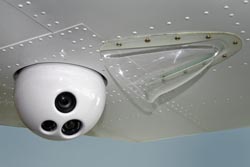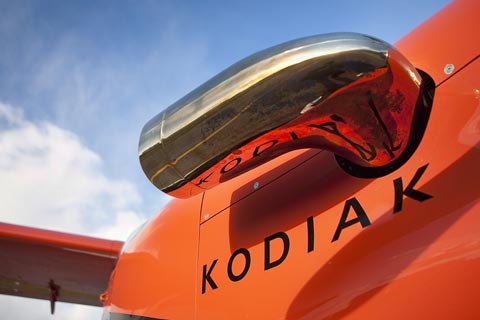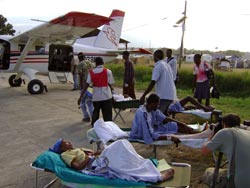Quest Kodiak: A higher calling
A rugged missionary that serves many roles
Kodiak camera
 The orange Quest Kodiak that provides daily traffic reports in suburban Washington, D.C., also has another job. The rugged airplane is an aerial test bed for a sophisticated camera and sensor system designed by Bill Harvey, an engineer, inventor, and UAV pioneer. The camera system is mounted in a tiny ball turret that protrudes from the Kodiak’s belly, and it’s operated by a technician sitting at a console behind the cockpit crew. When the system is complete, Harvey says, it will be able to provide law enforcement and other government agencies with live streaming video that can help them perform their time-critical and potentially life-saving work. “All they have to do is let us know the GPS coordinates of the location they’d like to see and we’ll provide high-definition images that they can watch in real time on their laptop computers,” Harvey said. “These images will give agencies the vital information they need to coordinate their responses to a wide range of emergency and nonemergency situations.”
The orange Quest Kodiak that provides daily traffic reports in suburban Washington, D.C., also has another job. The rugged airplane is an aerial test bed for a sophisticated camera and sensor system designed by Bill Harvey, an engineer, inventor, and UAV pioneer. The camera system is mounted in a tiny ball turret that protrudes from the Kodiak’s belly, and it’s operated by a technician sitting at a console behind the cockpit crew. When the system is complete, Harvey says, it will be able to provide law enforcement and other government agencies with live streaming video that can help them perform their time-critical and potentially life-saving work. “All they have to do is let us know the GPS coordinates of the location they’d like to see and we’ll provide high-definition images that they can watch in real time on their laptop computers,” Harvey said. “These images will give agencies the vital information they need to coordinate their responses to a wide range of emergency and nonemergency situations.”
Rich Bettinger, a veteran pilot who flies the Kodiak for traffic survey flights for Montgomery County, Maryland, said the airplane can be surprisingly economical to fly, even at low altitude. “When you slow it down to 110 knots or so, the fuel burn gets down to about 30 gallons an hour,” he said. “That’s not too shabby for an airplane of this size.”
Harvey is CEO of the Brandebury Tool Co., a 14-employee firm in Maryland that develops and produces a wide range of UAV technology. He and his engineering team have developed small, composite UAVs for the U.S. military, and they own more than a dozen patents that include miniature camera and sensor systems.
The office walls at Brandebury are adorned with some of Harvey’s earliest designs, including a sweptwing UAV with a pair of jet engines from 1977. The company’s most popular products are extremely lightweight UAVs with electric motors with high-aspect-ratio wings that allow them to fly for many hours at a time.
Harvey said he chose the Kodiak as a test bed because the smooth-running PT6A–34 engine reduces vibration for the camera system. The Kodiak also offers large load-carrying capacity, a roomy interior, extremely long endurance, and short- and rough-field capabilities.
“Buying the Kodiak was a rational business decision,” said Harvey, 65, who also owns a Heliocourier. “But it’s motivated by my lifelong passion for aircraft. I’ve been building and flying model aircraft from a very young age, and I just absolutely love the Kodiak.” —DH

The view from the Quest Kodiak’s cockpit seems odd and mildly unnerving, although it’s precisely the kind of situation the rugged short-takeoff-and-landing airplane is built for.
Lined up for takeoff on a lumpy, cracked, 2,000-foot-long asphalt runway just 25 feet wide with a clump of tall trees at the departure end, the picture would seem appropriate from a Super Cub or Husky. From the elevated perch of a roomy, climate-controlled turboprop, however, the feeling is reminiscent of a Pilatus PC–12 or a TBM 700, so the rugged surroundings appear a bit incongruous.
And even though the performance charts show the Kodiak is capable of vaulting off much shorter airstrips than this one (Maryland’s Davis Airport), it seems like an awfully big airplane for such a small place.
“Those trees are no concern to us,” says Kenny Stidham, a Quest test pilot, dismissively. “We’ll clear them by a country mile.”
With flaps set at 20 degrees, rudder trim deflected halfway to the right, the prop in high pitch (2,200 rpm), and 1,600 foot pounds of torque, the Kodiak surges forward to its rotation speed of 55 KIAS and jumps into the air after a ground roll of just 300 feet. The best angle of climb airspeed, 72 KIAS, produces a 2,000-fpm rate of climb; with flaps retracted at 100 KIAS, the rate increases to 2,300 fpm.
The 50-foot trees look tiny as we pass 1,000 feet overhead.
Even though we take off in near-optimal conditions (35 degrees Fahrenheit, six-knot headwind, half fuel, and three people aboard), the boxy metal airplane’s eagerness to catapult itself skyward is astonishing. Equally impressive, the airplane makes few demands of the pilot as its handling mixes docility and obedience with gravity defying power.
Missionaries’ position
 Quest Aircraft Co. was founded with a higher calling. The company’s sole purpose was to create a clean-sheet aircraft that would allow missionary and humanitarian organizations to safely perform their demanding work in some of the world’s most remote and inhospitable regions.
Quest Aircraft Co. was founded with a higher calling. The company’s sole purpose was to create a clean-sheet aircraft that would allow missionary and humanitarian organizations to safely perform their demanding work in some of the world’s most remote and inhospitable regions.
Conversations between Tom Hamilton, co-founder of the Stoddard-Hamilton Experimental aircraft series (Glasair and Glastar), and pilots from the Missionary Aviation Fellowship got things started. Quest was founded in Sandpoint, Idaho, in 2001, and a list of missionary and humanitarian organizations provided the seed money to get their new aircraft built and FAA certified. After that, commercial aircraft sales would fund deeply discounted airplanes for the original investors to carry out their charitable work.
So far, it’s pretty much worked that way. Quest has produced and delivered 47 airplanes, and nine of them are working in remote areas such as New Guinea, Indonesia, and Africa. The others are being used as aerial SUVs, jump planes, Part 135 charters, and floatplanes, and they’re owned by individuals, businesses, and government agencies. The proceeds for each nine airplanes Quest sells to retail customers are used to build one for the service organizations that helped found the company and launch the Kodiak. Quest and its roughly 130 employees manufacture Kodiaks at an 84,000-square-foot production facility in Idaho.
Everything about the Kodiak is dictated by the harsh nature of its uncompromising mission:
- The Pratt & Whitney PT6A-34 turboprop engine (750 shaft horsepower) was selected because 100LL has become scarce or completely unavailable in remote corners of the world.
- Tall gear and 29-inch main tires provide 19 inches of ground clearance for the four-blade Hartzell aluminum prop, a vital consideration when flying in and out of rough airstrips.
- An oversized oil cooler allows operation in equatorial regions and temperatures as high as 131 degrees F (55 degrees C).
- A 49-inch-square cargo door allows the unloading of palletized containers.
- A cuffed wing with a downturned outboard section lowers the angle of incidence and keeps the ailerons effective even after the wing roots have stalled.
- A rubberized floor and metal tie-down straps secure cargo.
- Two 24-volt Concorde batteries linked in series provide up to 48 volts for high-and-hot starts.
- An inertial separator (which is electronically actuated) keeps the engine from ingesting debris.
A three-screen Garmin G1000 suite with synthetic vision allows pilots to avoid terrain in mountainous areas.
“We know these airplanes are likely to be flown extensively in mountainous areas so we make sure synthetic vision is standard equipment,” Stidham said. “We want all our customers to have the safety benefits that come with it.”
Walking around the Kodiak, comparisons with another large, single-engine, fixed-gear, high-wing turboprop—Cessna’s 208 Caravan—are unavoidable. But Quest officials say the two airplanes are quite different. The Caravan was designed to carry air freight from one hard-surface runway to another. The Kodiak was made specifically for bush flying, and its real competitors in the Cessna line are piston aircraft such as 206s, 207s, and 185s (as well as other backcountry stalwarts such as de Havilland Beavers and Otters).
The Kodiak’s systems were designed for simplicity, reliability, and ease of maintenance. The airplane carries 320 gallons of fuel in two wing tanks that gravity feed to the engine. Two fuel selectors are normally left On at all times in flight. A pair of magnetic fuel quantity gauges can be checked from the ground without climbing atop the wings.
The electrical system is charged by a 300-amp generator and a 40-amp alternator. In case of a generator failure, the alternator can power essential systems, including an optional TKS anti-ice system, pitot heat, lights, and the left-side PFD on the G1000.
The cockpit is located forward of the wing’s leading edge and provides excellent forward and downward visibility. Climbing in with the aid of a built-in step (embossed with the company’s bear footprint logo) is a bit like stepping up to the cab of a semi.
Crew seats are leather (even in the baseline “Tundra” interior) and adjust fore and aft and up and down; the back articulates, and they have armrests. The Kodiak has extraordinary endurance of up to 11 flight hours, so comfortable seats are imperative.
Between the two seats an optional TKS tank holds more than 16 gallons of anti-ice fluid—enough for 2.5 hours of coverage at the maximum flow rate and nearly four hours at a normal rate. Oxygen is standard for the crew and an option for passengers. Inflatable door seals are meant to reduce cabin noise as well as exhaust fumes that tend to enter the cockpit during the landing flare.
The panel is logically arranged with a cluster of engine-start switches on the far left, lights in the center, and the anti-icing system below. Three-axis trim is actuated manually with pitch-trim wheel on the power pedestal or electrically using a thumb switch on the yoke; aileron trim is manipulated via a pair of rocker switches atop the pedestal, and rudder trim is adjusted with another rocker switch on the vertical portion. Also, pitch trim moves automatically when flaps are deployed so that the pilot need only fine-tune the trim instead of making coarse and rapid adjustments. All trim indications are shown on the G1000 MFD.
A touch-screen environmental control system lets the crew set the desired cabin temperature, and heat and air conditioning (AC is an option) come on and off automatically to maintain that temperature.
“Plop it and stop it”
The start sequence is standard PT6 and a checklist on the G1000 MFD screen guides the crew through the process. Fuel pump On; starter motor to High; ignition On; at 14 percent rpm, push the fuel condition lever to low idle and monitor ITT (which typically peaks at about 600 degrees).
Taxiing is standard with Cleveland hydraulic double-puck toe brakes. The nosewheel is steerable through 17 degrees of travel (left and right) but free casters during sharper turns to provide an exceptionally small turning radius.
Critical items on the pretakeoff checklist are familiar: flaps (20 degrees); rudder trim deflected halfway right; high idle; 1,600 pounds of torque for a target (maximum 1,795 pounds). Acceleration is rapid, and holding the centerline requires significant right rudder pressure, even with the rudder trim deflected. Rotate at 55 KIAS and the airplane just seems to levitate off the ground and accelerates smoothly while climbing in a 15-degree pitch attitude.

There’s very little settling as the Fowler flaps are retracted (at 85 KIAS minimum) and the airplane quickly accelerates to a 120-knot cruise climb. Reducing the prop speed to 2,000 rpm is a simple matter of pulling the prop lever back to the first detent. Typical cruise for the Kodiak at 12,000 feet is 175 KTAS with a fuel burn of 300 pounds (45 gallons) an hour. The Kodiak is certified to 25,000 feet, but most owners prefer nonoxygen altitudes and seldom fly in the flight levels.
At economy cruise, the Kodiak has a remarkable range and endurance that can easily exceed 10 hours and 1,100 nm in no-wind conditions. At more customary cruise speeds and altitudes, the airplane can fly about six hours with IFR reserves.
Control forces are moderate to heavy, especially the ailerons at speeds above 150 KIAS, but not unpleasant or unmanageable. Unaccelerated stalls in a clean configuration are preceded by mild airframe buffeting and gentle break at 74 KIAS, accompanied by a slight left-wing drop. Stalls at full flaps (35 degrees) require idle power because any help from the fan up front will keep the wing flying. At a scant 300 pounds of torque, for example, the Kodiak seemed perfectly content in slow flight at just 50 KIAS. Pulling the power and yoke all the way aft resulted in a docile wings-level break at 58 KIAS. Steep turns at 60 degrees of bank are extremely stable, and the airplane shows no overbanking tendency.
Slowing down and going down in the descent was a simple matter as we approached AOPA’s home base at Frederick Municipal Airport in Maryland for a series of takeoffs and landings. At pattern altitude a power setting of 500 pounds of torque brought the Kodiak below its 138-KIAS flap speed.
 Pitch trim compensates automatically for each flap setting, and the manual trim wheel spins on its own as the Kodiak adjusts for each new configuration. With full flaps and 74 KIAS on final approach, the Kodiak gave plenty of time to round out and flare. The counterweighted elevator has tremendous authority, and keeping the nosewheel off the pavement is a simple matter after the main gear touches down.
Pitch trim compensates automatically for each flap setting, and the manual trim wheel spins on its own as the Kodiak adjusts for each new configuration. With full flaps and 74 KIAS on final approach, the Kodiak gave plenty of time to round out and flare. The counterweighted elevator has tremendous authority, and keeping the nosewheel off the pavement is a simple matter after the main gear touches down.
Normal landings with light braking were smooth and consistent, but the Kodiak wasn’t meant for such gentle treatment. At Stidham’s request, we tried a few “plop-it-and-stop-it” landings that dramatically reduce the amount of runway required.
Slowing the final approach speed to 70 KIAS, eliminating the flare, and briskly flattening the prop to its Beta setting on touchdown while simultaneously moving the condition lever to low idle, raising the flaps, and braking aggressively brought the ground roll to less than 700 feet (with the aid of a seven-knot headwind). The Kodiak’s maximum demonstrated crosswind component is 20 knots.
“You can land the Kodiak gently, or you can land it short,” Stidham said. “But you really can’t land it gently and short.” Stidham, a six-year Quest veteran, is one of the company’s more senior employees. “There were only 30 people at Quest when I started,” said the former corporate pilot and A&P mechanic. “So I’ve seen a lot of changes in a short period of time.” Short-field takeoffs were particularly impressive.
Holding the brakes with flaps at 20 degrees, rudder trim set, high idle, and 1,700 pounds of torque requires stronger legs than mine. The stall warning chirped near the 50 KIAS rotation speed, but the airplane’s angle of attack quickly diminished as airspeed increased beyond 100 KIAS in a 17-degree nose-up pitch attitude. Ground rolls were typically no more than 350 feet.
Despite having occupied the left seat for less than one hour, the airplane’s performance (and Stidham’s presence) gave me the confidence to try the much shorter, narrower, uneven, and obstructed Davis Airport. I needn’t have been concerned as the Kodiak handled those aspects of its new surroundings with casual indifference.
Shutdown at the airplane’s home base of Montgomery County Airport in Gaithersburg, Maryland, was standard, too: low idle, prop feather, generator and alternator Off, and fuel condition lever to Cutoff.
Serving them all
The Kodiak was made for missionaries and the company is proud of its airplane’s role in doing good works and saving souls. But the Kodiak’s robust design, rugged construction, and attention to detail are meant for the here and now—not just the hereafter.
Aluminum castings on its landing gear appear capable of withstanding severe abuse. And the six tracks for its Fowler flaps are strong enough to hang from and do pull-ups. Interior details, logical layout, and fit and finish are highly refined—unusual attributes for a relatively young company that has manufactured fewer than 50 airplanes.
Quest’s uncompromising approach to designing and building the Kodiak for its own special mission has resulted in a versatile aircraft that can accomplish many other tasks, too—and buyers ranging from parachute jumpers to government agencies have figured that out. And whether customers intend to carry third-world tribesmen to distant medical care or hunters into and out of the wild, Quest is devoted to serving them all.
E-mail the author at [email protected]. Photography by Chris Rose, Brandebury Tool Co., Kodiak.


